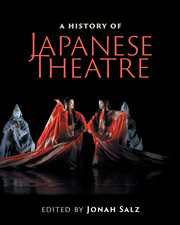Book contents
- Frontmatter
- Contents
- List of figures
- List of tables
- Contributors
- Contributors’ biographies
- Foreword
- Acknowledgments
- Note on Japanese terms
- List of abbreviations
- Timeline
- Editor's introduction
- I Traditional theatres
- Preface to Part I Japanese civilization arises
- II Modern theatres
- Preface to Part II
- III Arcs and patterns
- IV Theatre architecture
- Preface to Part IV Evolution of Japanese theatre architecture
- V Theatre criticism
- VI Intercultural influences
- 22 Seven stages of Shakespeare reception
- 23 Traditional training internationally
- 24 Intercultural theatre: fortuitous encounters
- Interlude Early influence from Europe
- Interlude Asian energy versus European rationality: interview with Ninagawa Yukio
- Epilogue: Frozen words and mythology
- Further reading
- Index
- References
23 - Traditional training internationally
from VI - Intercultural influences
Published online by Cambridge University Press: 05 July 2016
- Frontmatter
- Contents
- List of figures
- List of tables
- Contributors
- Contributors’ biographies
- Foreword
- Acknowledgments
- Note on Japanese terms
- List of abbreviations
- Timeline
- Editor's introduction
- I Traditional theatres
- Preface to Part I Japanese civilization arises
- II Modern theatres
- Preface to Part II
- III Arcs and patterns
- IV Theatre architecture
- Preface to Part IV Evolution of Japanese theatre architecture
- V Theatre criticism
- VI Intercultural influences
- 22 Seven stages of Shakespeare reception
- 23 Traditional training internationally
- 24 Intercultural theatre: fortuitous encounters
- Interlude Early influence from Europe
- Interlude Asian energy versus European rationality: interview with Ninagawa Yukio
- Epilogue: Frozen words and mythology
- Further reading
- Index
- References
Summary
Knowledge of Japanese traditional theatre outside Japan took many forms: from travel accounts by visitors, tours abroad, translations, and lecture-demonstrations (see Chapter 21, p. 463). For nearly a century, intensive, custom-made training programs by Japanese masters have existed, flourishing today in domestic and international courses and collaborations.
Fascination, imitation, acquisition, adaptation
As with so much else in twentieth-century intercultural performance, such experimental experiential learning began with Denishawn, the dance company of Ruth St. Denis and Ted Shawn. While on an extended tour of Asia in 1925 with a fifty-person troupe, they were particularly fascinated with kabuki, taking personal lessons from star actor Matsumoto Kōshirō VII (1870–1949) and his Fujima dance school. While in Tokyo, members trained four hours a day for thirty-six days at Imperial Theatre rehearsal rooms or rooftop, accompanied by shamisen. Film excerpts of young Denishawn dancers show a high-spirited but serious group absorbing the choreography of Momijigari (A maple-leaf viewing party).
While recognizing the value of their experiences, the two company heads deviated on how best to appropriate the acquired techniques. Shawn, who had succeeded with his pseudo-Japanese Spear Dance (1919), learned how to apply authentic kabuki makeup, then purchased a wig, fans, and expensive costumes. He performed both Princess and Demon roles in a condensed version of Momijigari on Denishawn's triumphal return tour 1926–7 throughout the USA; however, it was not revived.
St. Denis had long been fascinated by Japan, studying dance with a “former geisha” in Los Angeles for six weeks prior to her acclaimed 1913 O-Mika. This employed remarkably authentic backdrops and costume; photographs displaying a stillness and frenzy perhaps influenced by Sadayakko, whom St. Denis had seen at Loie Fuller's Exposition in Paris. When actually visiting Japan, however, she contented herself merely observing; a promotional film catching her posing in kimono holding a shamisen. Like Shawn, she respected the forms and spirit she witnessed: “If you will master to any degree the Japanese art of dance, anything else you do will be better done. For … I know nothing, not even the ballet at its strictest, which can exceed the precision and discipline of Japanese technique,” which, if mastered, “everything else you do will be better done.”
- Type
- Chapter
- Information
- A History of Japanese Theatre , pp. 497 - 512Publisher: Cambridge University PressPrint publication year: 2016



